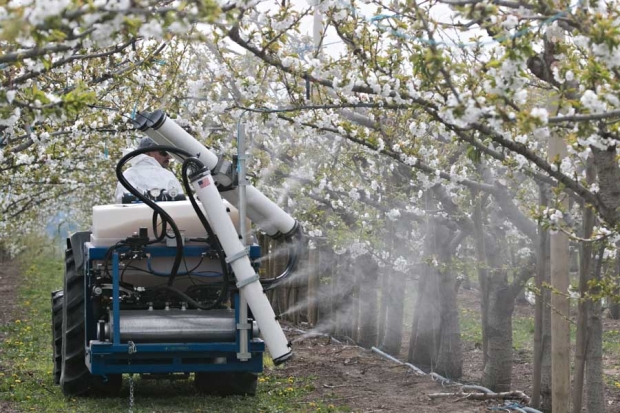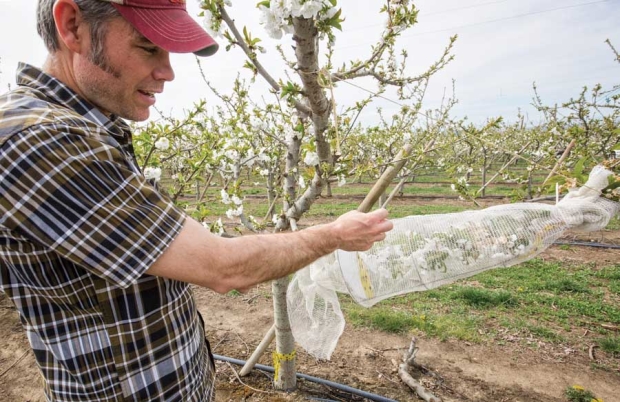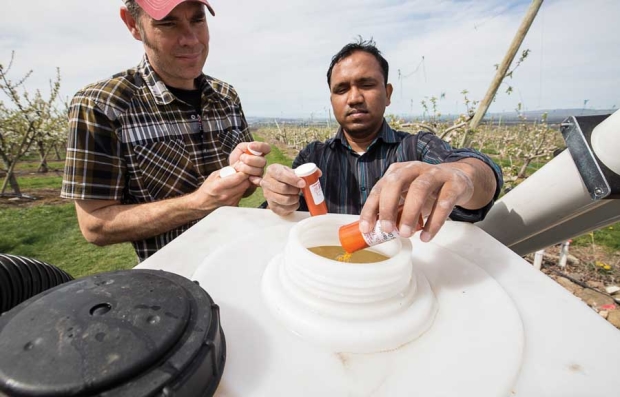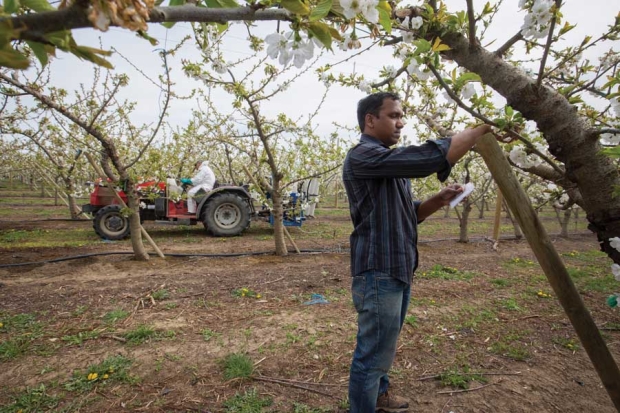Pollination comes with problems. Bloom dates don’t overlap, honeybee colonies fail, weather doesn’t cooperate. The list goes on.
Matt Whiting foresees a day when none of that matters.
“What if I were to tell you now that everything you’ve heard … wouldn’t be an issue any longer? No problems with pollinizers, no problems with pollinators,” Whiting said to growers at the December Washington State Tree Fruit Association Annual Meeting in Yakima, Washington. “That in a nutshell is the vision that we have here.”
After two years of experimenting, the stone fruit physiologist and his collaborators believe they have developed an effective artificial pollination system that uses an electrostatic sprayer to apply a suspension of pollen to flowering fruit trees.
Welcome to Whiting’s vision of farming without bees.
About the completed project

Whiting, with Washington State University, started the project in 2014, when he sprayed an existing slurry of pollen and other compounds available through pollen companies.
In 2015, he and some engineering faculty at the WSU Irrigated Agriculture Research and Extension Center tried out their own homemade suspension, using a sucrose agent that kept pollen viable for one hour.
Through the spring of 2015, Whiting ran trials in cherry, pear and apple orchards around the state.
In each one, using his spray as a supplement to bees, he increased pollen density per stigma compared to natural pollination, sometimes threefold. Fruit set improved anywhere from 10 percent to 200 percent when used to supplement bees.
To test his pollen agent by itself in a controlled environment, he covered several tree branches with nets to keep the bees out.
In each of those trials, his sprays worked, but fell well short of natural pollination. So, he’s a long way from putting bees out of work.
Whiting also tinkered with different rates and realized that increasing the pollen per acre boosted fruit set only to a point.
After that, it didn’t seem to matter how much he used, he said, but he wants to further study rates, timing and concentrations.
Grower cred

Whiting struggled for years to have his work taken seriously. About five years ago, grant programs from the U.S. Department of Agriculture called his proposals “too science fictiony,” he said.
However, his experiments in 2014 and 2015 — funded by a $61,209 grant from the Washington Tree Fruit Research Commission — have given him credibility, especially among growers, he said.
“The thing that we have now is proof of concept,” Whiting told Good Fruit Grower. “With that proof of concept has come a lot of grower interest.”
All the growers he worked with on the project asked him to return the following year.
A few have purchased their own electrostatic sprayers and plan to do even more pollinating without him, purchasing directly from pollen suppliers.
A group of California growers has invited him to visit to discuss his work.
“I like the concept,” said Denny Hayden, a Pasco, Washington, cherry and apple grower. “We’ll see if the idea proves out, but the concept is great.”
Hayden’s biggest frustration with honeybees is weather. Cold or windy weather grounds bees, sometimes while the blossoms are at their peak fertility.
“You have, in some cases, hours to get the pollen transferred,” said Hayden, a former member of the tree fruit research commission.
Growers pay anywhere from $40 to $70 per hive each season. Recommendations call for two hives per acre, though most growers use way more to sleep better at night. Hayden has been known to triple that number.
Luke Anderson, an orchard manager for Allan Brothers, has invited Whiting to try his method on a block of Benton cherries near Mesa, Washington, where he has trouble setting fruit.
“If we can even get close to manipulating (pollination) in our favor, I’m not surprised growers are excited,” Anderson said.

The owner of the pollen company collaborating on the work is just as pumped.
“I’ll tell you … it works,” said Neil McClure, owner of Firman Pollen Co. in Yakima, Washington.
The industry, with high-density fruit walls and science-based methods, is ready for a new method of pollen delivery, McClure said.
McClure admits Whiting still has to answer a lot of questions before he proves the technology is applicable for widespread commercial use, but he believes it’s only a matter of time, perhaps 20 or 30 years.
“Truly a revolution in growing,” he called it.
Others are more reserved.
“I don’t think I’m going out of business any time soon,” Eric Olsen, a Yakima commercial beekeeper, quipped during the tree fruit association conference after hearing Whiting speak.
Andy Gale, general manager of Stemilt Ag Services, conducted his own 2015 trials with an Arizona spray vendor on a hard-to-set block of Bing cherries in Mattawa, Washington.
“We really couldn’t see the results, to be honest with you,” he said, admitting he relied only on “naked eye” perceptions.
He plans to try again this year, perhaps taking more precise measurements of fruit set, he said.
Background
Declining health of honeybee hives has captured national attention, with research funding going to searches for alternative pollinating insects and development of honeybee forage plants.
Education grants send money to high school teachers to conduct bee projects in their classrooms.
Meanwhile, growers already have the option of mechanical pollination, applying pollen as dust with puffers they carry by backpack or mount on an all-terrain vehicle.
The method is common in the kiwifruit industry, but tree fruit growers such as Stemilt use it, too. Pollen is a hardy substance that will last for years when kept dry and cold.
But even McClure of Firman Pollen admitted dusting is inefficient, suited best for targeted supplemental efforts, not the full coverage application Whiting proposes.

Meanwhile, pollen is in short supply. Firman cut back about 20 percent this year on its California deliveries, trying to keep Washington at full supply, McClure said. The company sells 2 million grams of pollen a year, for example.
If his idea takes off, Whiting envisions a day when growers plant trees just for pollen, creating a whole new industry, and pollinate only the number of blooms they want, eliminating the need for spring and summer thinning.
In fact, Allan Brothers of Naches, Washington, and Firman have planted pollen-only orchards to experiment with trellising and management systems, according to Whiting’s research documents.

“The ability to artificially pollinate tree fruit holds the potential to revolutionize crop load management,” Whiting said in his final report to the Research Commission. “Our vision for precision pollination systems that do not include pollinizers nor pollinators appears plausible. Clearly these results should be considered promising yet preliminary.” •
– by Ross Courtney






Thank you for the excellent and timely report on pollination. I must point out that some growers have utilized and profited from artificial, mechanical or controlled pollination since the early 1930’s. Neil McClure’s grandmother (and mine), Mina Firman, figured this out in 1933. Since then the company she founded has been selling pollen and advising growers on its use.
Please be kind enough to provide the name of the pollens variety…..
Great report! Can’t wait for the results! :)
Was this experiment successful……?
How much effective it was….. Plz do share the result….